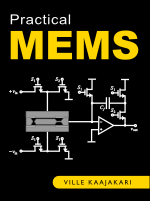
The Practical MEMS book focuses on analyzing the operational principles of microsystems. The salient features of the book include:
Tutorial approach. Practical MEMS book emphasizes the design and analysis through over 100 worked out examples covering all aspects of MEMS design.
Emphasis on design. This book focuses on physical operation principles and analyzing the device operation to satisfy the target specifications. Practical MEMS is the first textbook to focus purely on microsystem design and it is a perfect companion to MEMS fabrication textbooks.
Market driven coverage. Focus is on proven applications that are showing revenue growth. Emerging applications are evaluated in terms of competing technologies.
Quantitative performance analysis. The critical performance parameters for the given application are identified and analyzed. For example, the noise and power performance of piezoresistive and capacitive accelerometers is analyzed in detail. Mechanical, resistive, and circuit noise analysis is covered.
Application specifications. Different MEMS applications are compared to commercial requirements. For example, the optical MEMS is analyzed in the context of bar code scanner, projection displays, and optical cross connect specifications.
MEMS economics and market analysis. A full chapter is devoted to yield and cost analysis of microfabricated devices. In addition, the market economics for emerging applications such as RF MEMS is discussed.
| WARNING |
|---|
The objects in this book are |